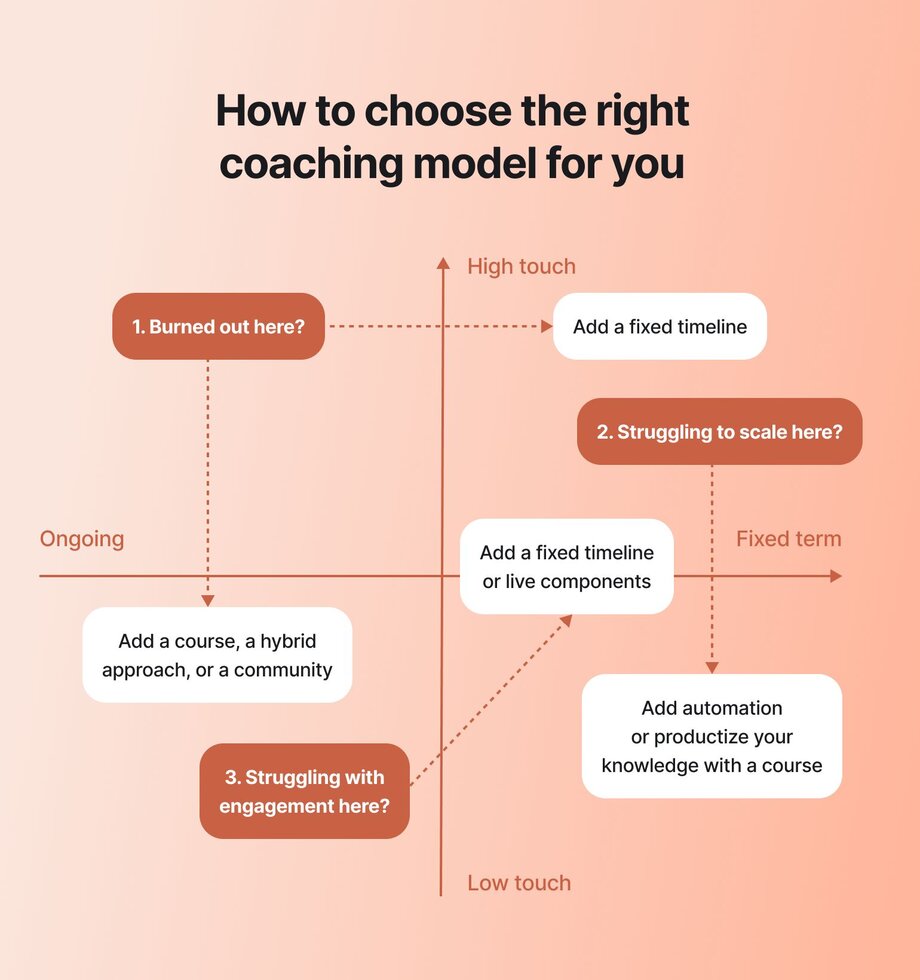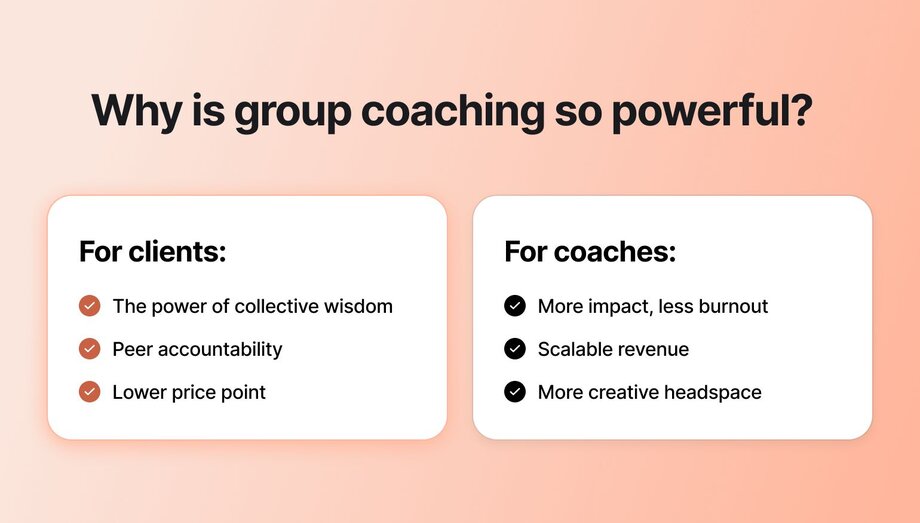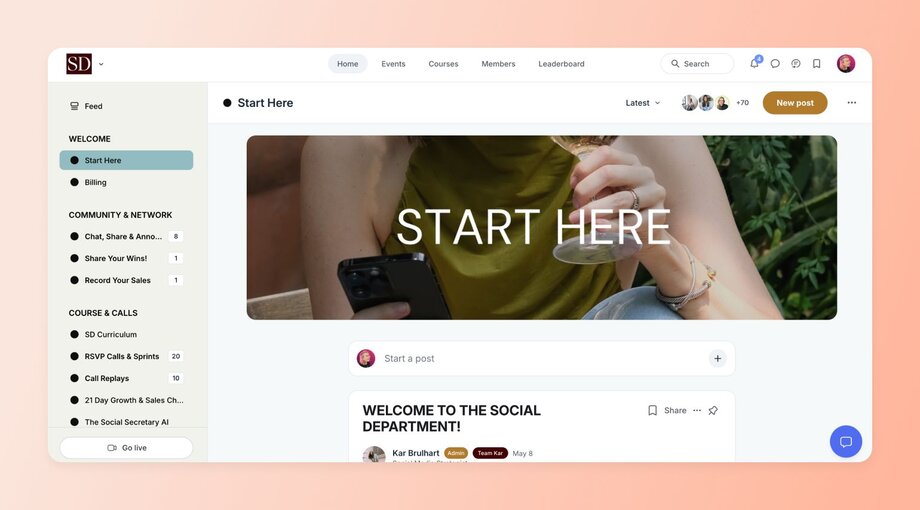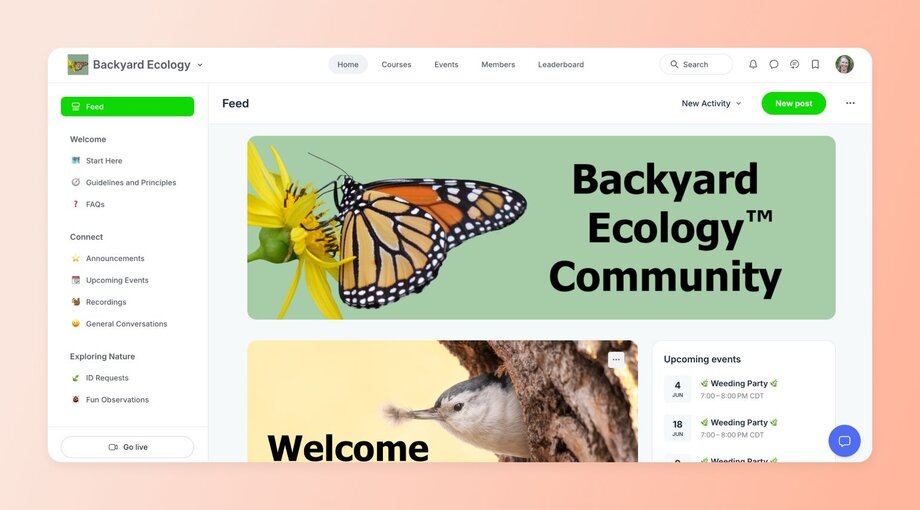Group coaching 101: Build, launch, and scale your first program
You may love the transformations you help clients achieve, and be exceptionally good at coaching. But if your calendar is packed with back-to-back calls that you’re starting to forget what free time feels like… Something’s gotta give.
This could be the perfect time to start thinking about expanding your practice into group coaching—before you start burning out.
With group coaching, you can tick three boxes:
✅ Helping more people
✅ Earning more money
✅ Doing the same work you love (minus the burnout)
If that sounds like a dream, keep reading. We’ll walk you through how to transition from 1:1 sessions to group coaching the right way—from choosing the best model, to setting your prices, structuring your program, and launching with confidence.
First up—what is group coaching?
Group coaching is a format where you work with multiple clients at once, usually in a live, interactive setting. It blends structure with flexibility, offering personal support, peer accountability, and collective learning. Clients benefit not only from you but also from each other.
Group coaching vs. mastermind vs. online course vs. coaching communities
It helps to know where group coaching fits in the broader ecosystem of coaching and online programs. People often confuse it with other formats, especially masterminds, online courses, and coaching communities. While there’s some overlap, they are quite different.
Here’s the quick breakdown👇
| Aspect | Group coaching | Mastermind groups | Online courses | Coaching communities |
|---|---|---|---|---|
| Level of coach interaction | Moderate to high | Low to moderate | Low | Low to moderate |
| Peer-to-peer learning | High | Very high | Low | Medium to high |
| Live sessions | Yes, regularly scheduled | Yes, but often peer-led | Not usually (unless cohorted) | Optional or periodic |
| Main focus | Personal growth + peer support | Collective insight + networking | Skill-building + self-paced learning | Connection + light guidance |
Group coaching sits right in the middle of these formats. It’s more hands-on than an online course or coaching community, but less intensive than a mastermind. It strikes a balance between personal attention and scalability—and when done well, it brings together the best of all worlds.
Why group coaching—and why now?
If you’re already working with clients 1:1, group coaching could be a natural next step. You might also want to consider productizing your process into a course, hiring other coaches to support your clients, or even creating a digital product.
Anyway, back to the group coaching, there’s also a strong business case for making the switch. Running your business purely on high-touch, 1:1 services can only take you so far. It’s hard to scale, and it takes a lot of time. With group coaching, you can charge each person a bit less, but serve more clients overall—leading to higher total earnings and fewer hours.
There’s also a shift happening in what clients want. Yes, they still want your expertise—but they’re also looking for community. They want to connect with others on the same journey, ask questions, share wins, and stay accountable. Group coaching creates that shared space—something 1:1 coaching just can’t offer.
And if tech has been the thing holding you back? That’s changing fast. Today’s platforms make it easy to run group programs from start to finish: live calls, content delivery, discussions, and payments—all in one place.
Group coaching models: which one fits you?
You can run a group coaching program in different ways. A quick decision flowchart below can help you figure out your starting point:

Time-based models: Ongoing vs. fixed-term programs
- Ongoing: Members can join anytime. Great for steady revenue and continuous support.
- Fixed-term: Everyone starts and finishes together, similar to cohorted courses. Builds momentum and delivers a clear outcome.
Intensity models: High-touch vs. low-touch approaches
- High-touch: Weekly calls, feedback, private check-ins. More hands-on.
- Low-touch: More self-paced content, fewer live sessions. Easier to scale.
Technology-enabled models
Tech-enabled means using a coaching or community platform to fully run your program—live sessions, content, discussions, and payments all happen in one place. The platform essentially becomes the central hub for your group experience. And it doubles as your control center for the backend!
Hybrid models that combine group and 1:1 elements
Hybrid models mix group coaching with some 1:1 time. For instance, you can run weekly group sessions and toss in a private call each month. This way, you can still offer personal support while serving more people at once.
Benefits of group coaching for clients and coaches
At first glance, group coaching might seem like it mostly benefits the coach—for obvious reasons. But collective learning can be just as powerful for clients.
Let’s look at the benefits on both sides.

For clients:
✅ The power of collective wisdom: People learn better when they hear different perspectives. In one study of workplace coaching, employees in group settings scored 48% higher on knowledge tests than those coached one-on-one. Why? Because hearing others ask questions and exploring solutions together makes the material stick better and builds confidence.
✅ Peer accountability: A group setting is a motivator to show up in itself. Nobody wants to be the one who flakes or falls behind. Peer accountability can be extremely powerful in getting people to act and follow through.
✅ Lower price point: Private coaching isn’t always within reach. Group programs are a more affordable alternative—and could help you reach your target audience in an equitable way.
For coaches:
✅ More impact, less burnout: Group coaching gives you a way to reach more people without working longer hours.
✅ Scalable revenue: You’re no longer trading time for money. With group programs, you can build recurring revenue, productize your expertise, and finally step off the hamster wheel of back-to-back 1:1s.
✅ More creative headspace: Freeing up mental space as a coach is a real win. Group coaching gives you that mental space to think creatively, explore new ideas, and come up with other ways to grow and monetize your coaching business.
So, how do you shift from 1:1 to group coaching while still maintaining high-quality interactions with your clients? We’ll get into that next.
How to transition from 1:1 coaching to group coaching without losing depth
Start by identifying which clients would benefit most from group settings
Not everyone is a fit for group coaching. From your 1:1 clients, look for people who:
✔ Ask similar questions
✔ Share a common goal
✔ Are open to learning with others
Bonus: While you shouldn’t anchor a group coaching program based on affordability, think about whether clients or prospects who have asked about payment plans or other payment options have anything in common, as well.
These clients will have the most in common with each other. But even after identifying the best fits for the program, don’t dive in headfirst. Start with a smaller pilot group to test things out.
Rethink your pricing strategy
Some of your clients might see group coaching as a more affordable way to work with you, which can be a selling point. Others might hesitate if the price isn’t that much lower than 1:1, especially if they don’t understand the unique value of a group format.
You’ve got to balance the price with the perceived benefits. Group coaching isn’t a “cheaper alternative” per se. It’s a different product. You’re offering coaching time, yes, but also community, accountability, and structured transformation. (And possibly, in a more asynchronous way!)
Designing scalable frameworks that still feel personal
Once you start running groups, you’ll notice you’re repeating a lot of the same things—onboarding, check-ins, progress tracking, and feedback. That’s your cue to build a simple framework (or an SOP–standard operating procedure), so you’re not reinventing the wheel every time a new member joins.
However, you still want to keep your coaching program feeling personal. So, bake in small high-touch moments, such as personal messages, shoutouts, and custom feedback, to create a more personalized experience.
💡Pro tip: SOPs are how Bonnie Christine started actively scaling her education and coaching business to 7 figures.
Learn how to lead and balance group dynamics
Another big job for you? Managing the group. You’ll have an over-sharer who answers every question (twice), and the quiet lurker who might not say a word unless you call on them.
A few ways to keep things balanced:
- Set clear expectations: Let people know how the sessions will run, how they can participate, and what’s expected of them.
- Manage talk time: Use things like round-robin sharing or time limits so everyone has space to contribute.
- Create a safe space: Show vulnerability yourself and invite people in—not call them out. Group culture starts with how you lead.
Reevaluate the tech tools powering your coaching experience
If you got away using only Zoom + email combo to run your 1:1 sessions, you’ll probably need to rethink your setup as you start group coaching. More people = more admin. Plus, you’ll also need a space where your clients can interact with each other.
For example, a platform like Circle can help you manage your community, deliver content, and host discussions all in one place, without sending clients chasing links or digging through email threads looking for onboarding docs or where to drop their weekly check-in. Investing in a purpose-built setup can save a lot of stress down the line.
That’s exactly what Kelsea found when setting up her Back without Burnout program on Circle:
“Circle has been instrumental in creating a safe community for my Back without Burnout members! It's so helpful to have everything in one spot for them.
They can log in to the app and find calls, call recordings, and any content, and they can connect with each other for accountability.
On my end, the automations I have set up make it easy when someone joins to find everything they need without any manual input from me!”
—Kelsea Warren, MSW, Founder and Chief Happiness Officer at the Seamless Coach

Setting up your first coaching program–curriculum, format, activities
Okay, so how do you structure your coaching program? Here’s what to dial in before launch:
Determining your ideal group size
The sweet spot for the group size depends on how intimate you want your program to feel.
If you’ll be hands-on, stick to 8–10 members. Prefer facilitating discussions? You can scale up to 12–20 people. You can also coach 100+ people if you want to. But you’ll probably want to pair it with an online course. That way, people can learn on their own time while you use group calls for deeper support, Q&A, or community building.
Creating the right course structure
There’s no single “best” way to run a group program. But you do need a clear structure. Without it, things can start to fall apart fast.
Chances are you already know what kind of transformations your clients have had. Are those the same outcomes you want people to experience in group coaching? Then work backwards to build an authentic path that gets them there.
A few proven formats to help you design your curriculum👇
| Curriculum structure | Best for | How it works |
|---|---|---|
| Cohort-based coaching | Step-by-step transformation | Participants go through the same material on a set schedule, with weekly sessions and milestones |
| Hybrid program | Self-paced with coaching | Combines pre-recorded content with live coaching, allowing for self-paced learning plus group interaction |
| Accountability squad | Motivation + peer support | Clients are grouped into small squads who check in with each other between live group sessions |
Establishing clear expectations and boundaries
If there’s one thing that’ll save you from 95% of headaches, it’s this: set expectations early. Like, onboarding-stage early!
Let people know exactly what they’re getting into—what kind of access they’ll get to you, what kind of effort is required to get results, and how they’re expected to show up in the group. Are there weekly or monthly calls? Do they need to introduce themselves? Make all of that crystal clear from day one.
Jordan Godbey, founder of GrowthCommunity, has worked with 150+ coaches and creators, and he says one of the biggest reasons people leave is when the experience doesn’t match what they were sold.
The fix? Create a welcome guide that lays everything out. And don’t forget the tech walk-though. Show people how to join calls, find content, and manage notifications.
Designing engaging group activities and exercises
In 1:1 coaching, you’re focused on just one person. But in a group, you’ve got to get people interacting. That means planning activities—not just delivering content.
Try adding a few of these to your sessions:
- Breakout rooms: Perfect for peer support, reflection, or quick feedback rounds
- Hot seat coaching: One person gets coached, the rest gain insights (and usually ‘see’ themselves in it)
- Group challenges: Shared action steps or weekly/monthly mini-goals (we do this in our Circle customer community!)
- Polls or check-ins: Fast, low-lift ways to read the room and build connection
💡 Tip: Always mix up formats so your sessions have some rhythm.
Building in accountability
A mistake a lot of first-time group coaches make? They become “accountability babysitters.”
Clients should be showing up for themselves first and foremost. Because seriously—why the heck are they doing your program if they’re not planning to take it seriously?
That said, a little structure can help everyone stay on track.
Consider adding a few of these accountability mechanisms:
- A shared tracker or dashboard where people post weekly goals
- “Commitment circles” or accountability pods between sessions
- Quick goal shares at the end of each call: “What’s your focus this week?”
The business side of group coaching
Now, let’s talk money, marketing, and how to make your group coaching business sustainable.
Calculating optimal pricing and profit margins
Group coaching is usually priced 30–60% lower than 1:1 sessions. But that doesn’t mean you earn less—it just means you earn differently.
Check out a quick example to see the tradeoffs in both time and expected hourly earnings👇
| Coaching type | Clients | Price per client | Monthly revenue | Monthly hours | Est. hourly rate |
|---|---|---|---|---|---|
| 1:1 coaching | 6 | $750 | $4,500 | 48 hrs | $93/hr |
| Group coaching | 15 | $300 | $4,500 | 12 hrs | $375/hr |
This assumes:
- 1:1 coaching: ~2 hours per client per week (sessions + admin)
- Group coaching: One 90-min session + 90 mins of prep/follow-up per week
The bottom line? With group coaching, you're working 75% fewer hours for the same revenue, and earning 4x more per hour. 🤯
Marketing strategies specific to group programs
Just like with most coaching offers, you can’t go in with a hard sell. First, you’ll need a warm audience that’s receptive to your offer. But even then, your main marketing message needs to be less about “access to you” and more about the collective experience.
Focus on:
- The outcomes people can expect
- The journey they’ll go on
- The community they’ll be part of
Once that’s clear, lean into strategies that build excitement and show real proof of group learning and accountability.
Your strongest marketing channels:
- Email newsletter – Warm up leads with personal stories, behind-the-scenes, and early invites
- Social media (IG, LinkedIn, etc.) – Build buzz with testimonials, client wins, and the community vibe
- Landing page – Clearly outline the transformation, format, who it’s for, and key FAQs
- Waitlist funnel – Create anticipation and give early access to drive urgency
- Workshops or free events – Let people experience your coaching style and group energy firsthand
✨ Pro tip: Your coaching/community platform can be a great marketing tool, too!
For example, Kar Brulhart, founder of The Social Department, runs a group coaching program that helps coaches and service-based entrepreneurs grow engaged Instagram audiences and turn them into consistent sales. She wisely uses Circle not just to deliver the program but also to promote it. Kar shares behind-the-scenes tours and video walkthroughs of her Circle setup to help warm leads visualize the experience—and the results—before they join.
“Circle is also a part of my sales strategy,” she says. “We’ve built an amazing portal with asynchronous support, 2-day feedback turnarounds, and a clean experience that’s way better than clunky community spaces like Facebook.”
—Kar Brulhart, founder of The Social Department

Metrics you should you be tracking for group coaching
If your clients are attending sessions, smashing their goals, and the overall sentiment is that they’re super happy with your program—go ahead and pat yourself on the back!
But if something is off, the numbers will usually point it out.
👀 Keep an eye on:
- Customer acquisition cost (CAC) – How much it costs to get one new client
- Completion rate – The % of people who finish your program
- Churn rate – How many drop out before the end
- Attendance rate – How often clients show up to live sessions
- Engagement – Participation in group chats, calls, or submitted work
- Client outcomes – Document wins or transformations your clients report
Don’t obsess over every number (use Circle’s Activity Score for members to keep a general eye on things). But do make adjustments when something isn’t working.
Tools that help scale your operations without burning out
Once your group program picks up steam, so does the admin. Managing 15 clients at once? Just thinking about it is enough to break a sweat 🥵!
That’s why you need a tool like Circle to run the backend of your program!
Circle brings your community, coaching, and content into one simple, modern platform. You can host live group calls, run member discussions, deliver courses, and even process payments—all from the same place.
Need to engage people between sessions? Circle lets you send automated digests, trigger push notifications, and even set up custom workflows to follow up with quieter members. You can go as far as gamifying member engagement to recognize and celebrate active members with points, levels, and badges!
With Circle, you’re not just saving time. You’re creating a smoother, more professional experience that helps your clients stay engaged—and helps you scale your coaching business without burnout.
For example, Shannon, the founder of the Backyard Ecology Community, used Circle to host her program Design Your Pollinator and Wildlife Oasis: Garden-sized Plots. After a successful beta launch, she bundled her group coaching program with three months of community membership—all run through Circle.
“Everyone who participated loved it... many are still active members of the community,” she said. “I’ve since turned the educational parts into short on-demand courses, and continue the group coaching and support through our Circle forum and virtual meetings.”
—Shannon Trimboli, founder of Backyard Ecology

It’s a perfect example of how Circle lets you start small, test ideas, and build out a scalable coaching experience—without piecing together five different tools.
👉 Want to see it for yourself? Try Circle free for 14 days and see how much simpler group coaching can be.
Legal and ethical considerations
Lastly, to keep your program safe and respectful for everyone:
- Sign a coaching agreement that stipulates the scope of the coaching relationship, session frequency, fees, confidentiality terms, and cancellation policies
- Set group guidelines
- Emphasize confidentiality—what’s shared in the group stays in the group
- Refer out when issues go beyond your scope
- Comply with local laws (data privacy, disclaimers, payment processing)
Challenges of group coaching
Most new endeavors won’t be a home run from day one—and that includes any new formats you’re trying for your coaching business. The good news? You’ll get better at handling them over time.
So you’re not caught off hard, here are a few common ones—and how to navigate them (without losing your cool):
Handling dominant personalities
In every group, there’s usually someone who speaks first, talks the most, and seems to know it all. Research shows that these behaviors can create the illusion of expertise—even when it’s not there. It can also annoy quieter people around.
To prevent skewed dynamics:
- Rotate the speaking order to shift influence
- Give solo reflection time before open sharing
- Say, “Let’s hear from others,” to gently redirect without calling out the dominant member.
Also, make sure each client still gets some individual attention within the group. Do this by carving out time for quick 1:1 check-ins to help them work through specific challenges or get more tailored support. You could also think about a hybrid group coaching program that blends group dynamics with 1:1 check-ins.
Addressing varying levels of engagement
Some clients will be all in, others will hang back. That’s normal. What helps: clear expectations, weekly nudges (via email or your platform), and mixing up formats so everyone finds their stride.
💡Bonus tip: Shoutouts for wins (and making sharing a habit) can help pull quieter folks into conversations.
Managing scheduling across different time zones
You can’t please everyone, but you can make it work. Most coaches just pick a set time to run sessions that works for the majority, and send recordings to the rest.
But if someone never gets to join a live session, they may start feeling like they’re not getting their money’s worth. The simplest fix? Rotate your call times or offer two different time slots to cover more time zones.
Troubleshooting technical issues in virtual environments
Someone can’t hear. The screen won’t share. The meeting link is broken (again). Tech issues happen. Have a backup plan: shared docs with links and recording, clear session instructions, and always log in early to test your setup before going live. Or simply use Circle to prevent most of these issues altogether!
Ready to switch to group coaching?
If you're at that natural point where it’s time to shift from 1:1 sessions to group coaching, take the leap! Start with a pilot group to test the waters and fine-tune your operations before going all in.
And if you’re looking for an all-in-one, flexible tool to help you build a strong, engaged, and long-lasting coaching business and community under your own brand, check out Circle.
Try it free today and see what’s possible.